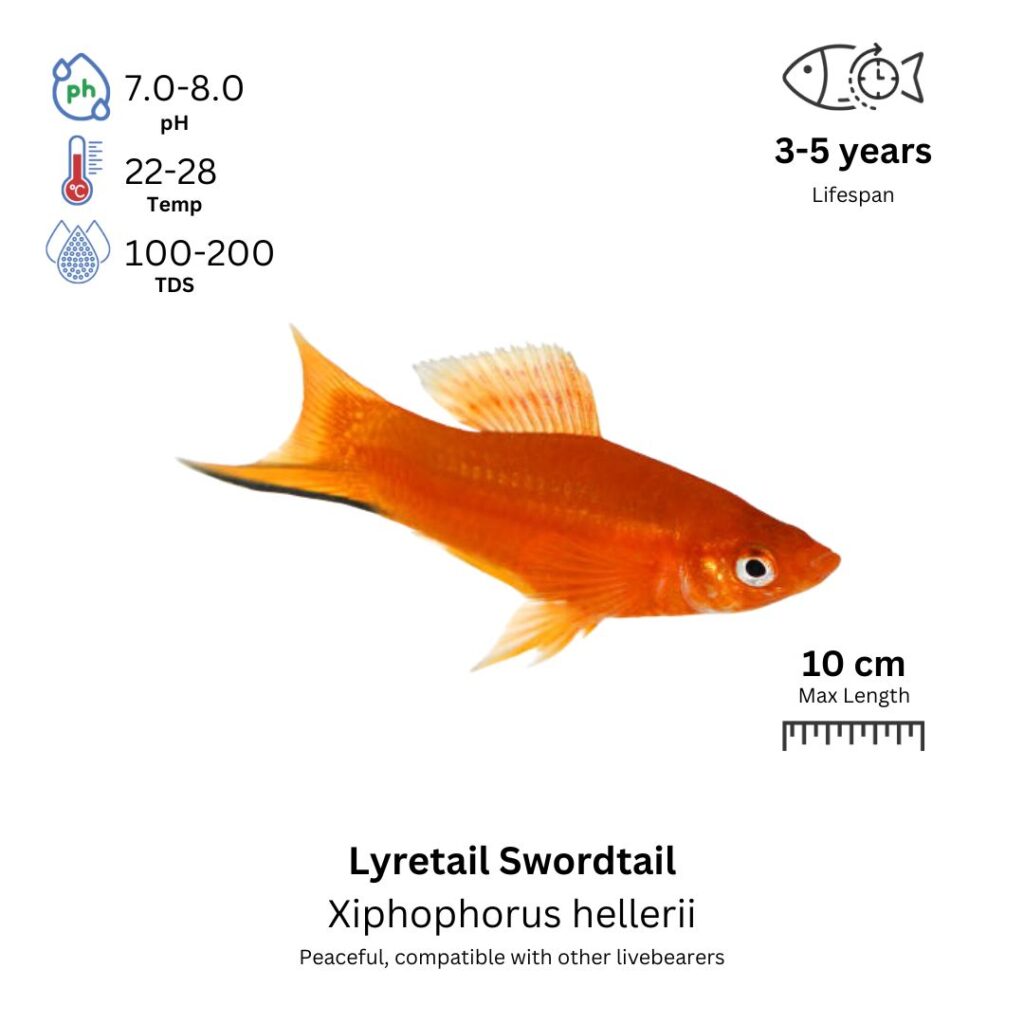Lyretail Swordtail
Xiphophorus hellerii

Description
The Lyretail Swordtail is a vibrant and visually striking variety of the Swordtail fish, renowned for its elongated and elegant tail fin, which has a “lyre” shape. The lyre-shaped tail is the defining characteristic of this variant, with the tail fins of males developing long, flowing extensions that create a graceful, ribbon-like appearance. These fish are usually brightly colored, with males displaying vivid shades of red, orange, and green, while females are typically less colorful but still possess the characteristic swordtail body shape. The body is generally slender and streamlined, with a slight curve and a smooth, metallic sheen.
Habitat Origin
Native to the freshwater lakes and rivers of Central America, especially from Mexico to Honduras. These fish prefer slow-moving waters with plenty of submerged structures such as plants, rocks, and fallen wood. In the wild, Swordtails live in neutral to slightly alkaline waters with moderate water flow. They thrive in well-oxygenated environments with moderate temperatures and plenty of vegetation.
Aquarium
Ideal Number in Aquarium: At least 6 individuals, as they are schooling fish and feel more secure in groups.
Favorite Food

Lyretail Swordtails are omnivores and will accept a variety of foods. They can be fed high-quality flake food, micro pellets, and live or frozen foods such as brine shrimp, daphnia, bloodworms, and grindal worms. They will also graze on plant matter, so offering blanched vegetables like zucchini, spinach, and lettuce is beneficial. A varied diet ensures they stay healthy and vibrant, especially when kept in community tanks.
Behavior:
Lyretail Swordtails are peaceful and social fish that thrive in schools. They are generally calm but may exhibit mild territorial behavior, especially males during the breeding season. Males use their long, lyre-shaped tail fins to attract females and engage in courtship displays. These fish are very active and enjoy exploring the tank, often seen swimming in the middle to upper levels. They are peaceful with other species and are ideal for community tanks with similarly sized and temperamental fish.
Special Care:
Lyretail Swordtails are hardy and easy to care for. However, they do need stable water conditions, regular water changes, and good filtration to thrive. Since they are livebearers, breeding may occur in the tank, so it’s important to manage the male-to-female ratio if breeding is not desired. These fish are also sensitive to high levels of ammonia and nitrates, so maintaining good water quality is crucial. They appreciate a well-planted tank with plenty of hiding spots for females, especially if males are being too assertive.
Compatibility with Other Fish:
Yes, Lyretail Swordtails are compatible with many other peaceful species. They can be housed with other small to medium-sized fish like tetras, rasboras, guppies, and corydoras catfish. They are also compatible with shrimp and snails. However, they should not be housed with larger, aggressive species that may bully them. These fish are ideal for peaceful community tanks where they can interact with other species that share similar water and temperature requirements.
Breeding Tank Setup
Although not strictly necessary, setting up a separate breeding tank for Lyretail Swordtails is highly recommended. This helps maintain stable water parameters and reduces interference from other tankmates during mating. A tank of 40–60 liters (10–15 gallons) is sufficient for the breeding pair and future fry. Water should be kept at a pH of 7.0–8.0, with a temperature of 24–28°C, and a hardness between 6–12 dGH. Install a gentle sponge filter or low-flow filter to ensure clean water without creating strong currents. Use fine gravel or sand substrate, and add smooth surfaces like ceramic plates or rocks for spawning, along with Java moss or floating plants for shelter.
Selecting Breeders & Conditioning
To condition Lyretail Swordtails for breeding, provide a protein-rich and varied diet over the course of several days. Live and frozen foods such as brine shrimp, daphnia, and bloodworms are effective in encouraging reproductive readiness. High-quality flake or pellet food can supplement their diet. Regular partial water changes (20–30%) and a slight increase in temperature to 28°C can help stimulate breeding behavior. Males will often display their long tail extensions and brighter coloration during courtship, signaling peak breeding condition.
Spawning Process
Spawning typically occurs in the early morning or late at night when the environment is calm. Lyretail Swordtails are livebearers, so fertilization happens internally, and the female gives birth to fully developed fry. A healthy female can release between 20–100 fry per cycle. After successful mating, it’s best to remove the male to minimize stress and repeated mating attempts. Providing dense plant cover ensures that newborn fry have safe hiding spots immediately after birth.
Fry Care & Feeding
The fry are born after a gestation period of 3–4 weeks, and they can swim and feed right away. In the first few days, feed them infusoria, liquid fry food, or finely crushed flake food. Once slightly larger, you can introduce newly hatched brine shrimp or microworms for more robust growth. To maintain a healthy environment, perform small water changes (10–15%) every 2–3 days, and ensure the temperature remains stable between 24–28°C. Use a sponge filter to keep water clean without endangering the fry.
Fry Development, Sexing, and Stress Prevention
Lyretail Swordtails reach sexual maturity at 4–6 months, though it’s best to breed only fully matured and healthy individuals. Males are distinguished by their bright colors and long sword-like tails, while females are larger, rounder, and plainer in color. To avoid stress, do not overcrowd the tank, and maintain consistent water parameters. Remove any aggressive tankmates, and avoid sudden changes in pH or temperature. With proper care, these active and visually striking fish will breed successfully in a well-managed aquarium.
